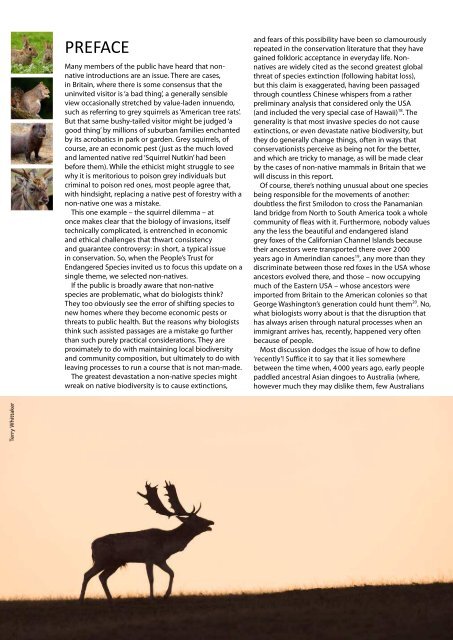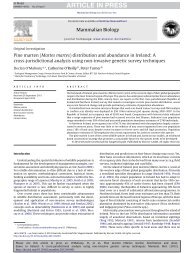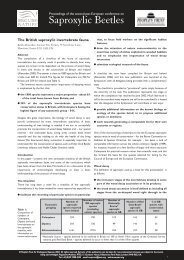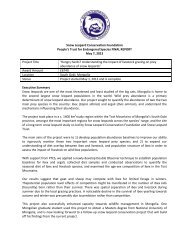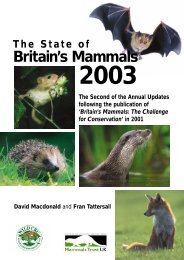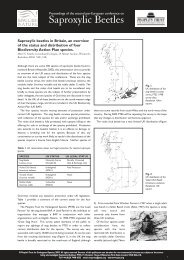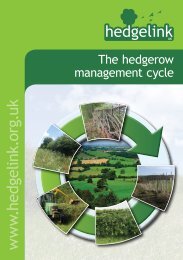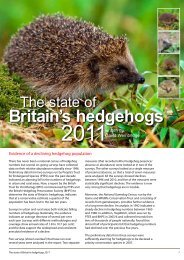The state of Britain's mammals - People's Trust for Endangered ...
The state of Britain's mammals - People's Trust for Endangered ...
The state of Britain's mammals - People's Trust for Endangered ...
Create successful ePaper yourself
Turn your PDF publications into a flip-book with our unique Google optimized e-Paper software.
Terry Whittaker<br />
PREFACE<br />
Many members <strong>of</strong> the public have heard that nonnative<br />
introductions are an issue. <strong>The</strong>re are cases,<br />
in Britain, where there is some consensus that the<br />
uninvited visitor is ‘a bad thing’, a generally sensible<br />
view occasionally stretched by value-laden innuendo,<br />
such as referring to grey squirrels as ‘American tree rats’.<br />
But that same bushy-tailed visitor might be judged ‘a<br />
good thing’ by millions <strong>of</strong> suburban families enchanted<br />
by its acrobatics in park or garden. Grey squirrels, <strong>of</strong><br />
course, are an economic pest (just as the much loved<br />
and lamented native red ‘Squirrel Nutkin’ had been<br />
be<strong>for</strong>e them). While the ethicist might struggle to see<br />
why it is meritorious to poison grey individuals but<br />
criminal to poison red ones, most people agree that,<br />
with hindsight, replacing a native pest <strong>of</strong> <strong>for</strong>estry with a<br />
non-native one was a mistake.<br />
This one example – the squirrel dilemma – at<br />
once makes clear that the biology <strong>of</strong> invasions, itself<br />
technically complicated, is entrenched in economic<br />
and ethical challenges that thwart consistency<br />
and guarantee controversy: in short, a typical issue<br />
in conservation. So, when the People’s <strong>Trust</strong> <strong>for</strong><br />
<strong>Endangered</strong> Species invited us to focus this update on a<br />
single theme, we selected non-natives.<br />
If the public is broadly aware that non-native<br />
species are problematic, what do biologists think?<br />
<strong>The</strong>y too obviously see the error <strong>of</strong> shifting species to<br />
new homes where they become economic pests or<br />
threats to public health. But the reasons why biologists<br />
think such assisted passages are a mistake go further<br />
than such purely practical considerations. <strong>The</strong>y are<br />
proximately to do with maintaining local biodiversity<br />
and community composition, but ultimately to do with<br />
leaving processes to run a course that is not man-made.<br />
<strong>The</strong> greatest devastation a non-native species might<br />
wreak on native biodiversity is to cause extinctions,<br />
and fears <strong>of</strong> this possibility have been so clamourously<br />
repeated in the conservation literature that they have<br />
gained folkloric acceptance in everyday life. Nonnatives<br />
are widely cited as the second greatest global<br />
threat <strong>of</strong> species extinction (following habitat loss),<br />
but this claim is exaggerated, having been passaged<br />
through countless Chinese whispers from a rather<br />
preliminary analysis that considered only the USA<br />
(and included the very special case <strong>of</strong> Hawaii) 18 . <strong>The</strong><br />
generality is that most invasive species do not cause<br />
extinctions, or even deva<strong>state</strong> native biodiversity, but<br />
they do generally change things, <strong>of</strong>ten in ways that<br />
conservationists perceive as being not <strong>for</strong> the better,<br />
and which are tricky to manage, as will be made clear<br />
by the cases <strong>of</strong> non-native <strong>mammals</strong> in Britain that we<br />
will discuss in this report.<br />
Of course, there’s nothing unusual about one species<br />
being responsible <strong>for</strong> the movements <strong>of</strong> another:<br />
doubtless the first Smilodon to cross the Panamanian<br />
land bridge from North to South America took a whole<br />
community <strong>of</strong> fleas with it. Furthermore, nobody values<br />
any the less the beautiful and endangered island<br />
grey foxes <strong>of</strong> the Cali<strong>for</strong>nian Channel Islands because<br />
their ancestors were transported there over 2 000<br />
years ago in Amerindian canoes 19 , any more than they<br />
discriminate between those red foxes in the USA whose<br />
ancestors evolved there, and those – now occupying<br />
much <strong>of</strong> the Eastern USA – whose ancestors were<br />
imported from Britain to the American colonies so that<br />
George Washington’s generation could hunt them 20 . No,<br />
what biologists worry about is that the disruption that<br />
has always arisen through natural processes when an<br />
immigrant arrives has, recently, happened very <strong>of</strong>ten<br />
because <strong>of</strong> people.<br />
Most discussion dodges the issue <strong>of</strong> how to define<br />
‘recently’! Suffice it to say that it lies somewhere<br />
between the time when, 4 000 years ago, early people<br />
paddled ancestral Asian dingoes to Australia (where,<br />
however much they may dislike them, few Australians<br />
would deny their Australianness), and around 1845<br />
when colonists did much the same with British red<br />
foxes (whose Australianness every Australian would<br />
deny). <strong>The</strong>re is an issue here about ‘naturalness’,<br />
touching on a pr<strong>of</strong>ound question <strong>of</strong> whether people<br />
are part <strong>of</strong> Nature and, if not, when they stopped<br />
being so. Some biologists attach very high value to<br />
natural processes, especially as they determine the<br />
geographical ranges, and hence natural communities,<br />
<strong>of</strong> species. It is a moot point whether a wider public<br />
can be convinced to attach a similarly high value to this<br />
<strong>for</strong>m <strong>of</strong> naturalness, in the context <strong>of</strong> the many other<br />
dimensions dictating how and why they value Nature.<br />
Things seem set to worsen. <strong>The</strong> biogeographical<br />
fall-out <strong>of</strong> the inter-continental musical chairs now<br />
being catalysed by man-made climate change further<br />
complicates the consequences <strong>of</strong> species being<br />
redistributed as they leak from unprecedented global<br />
trade 21 . In China this has led to a tenfold increase in the<br />
number <strong>of</strong> invasive species between 1990-2005 22 . In<br />
the United States, 35% <strong>of</strong> vertebrate families in which<br />
there is live-trade are now established as introductions<br />
outside <strong>of</strong> their native range 23 . Natural communities<br />
may become more susceptible to invasions ins<strong>of</strong>ar as<br />
their resilience deteriorates under pressure from habitat<br />
loss, hunting and climate change.<br />
<strong>The</strong>se global concerns spawned the Invasive Species<br />
Specialist Group (ISSG) in 1994 24 and the Global<br />
Invasive Species Programme (GISP) in 1997 21 . In May<br />
2008 Defra, the Scottish Executive and Welsh Assembly<br />
Government launched the Invasive Non Native Species<br />
(INNS) framework strategy <strong>for</strong> Britain to draw together<br />
the practicalities <strong>of</strong> prevention, detection and control <strong>of</strong><br />
species introductions, and to foster public engagement<br />
on managing invasive species. Most (84%) respondents<br />
(not, <strong>of</strong> course, a random sample) were supportive<br />
<strong>of</strong> lethal control policies, particularly those that were<br />
designed to address health, native species or economic<br />
issues 25 .<br />
Several times already we have mentioned the public’s<br />
view. This is because, while the introduction <strong>of</strong> nonnative<br />
<strong>mammals</strong> may be a biodiversity issue, their<br />
removal will almost invariably include welfare issues<br />
David Macdonald and<br />
Dawn Burnham with Fly<br />
and Qara, brother and<br />
sister trainee wildlife<br />
detection dogs.<br />
and, in travelling the road from science to policy, will<br />
necessitate judgment. In that context the public’s<br />
view will be decisive. So, in this personal perspective<br />
on introduced <strong>mammals</strong> in Britain, our purpose is not<br />
only to provide a ready reference <strong>for</strong> pr<strong>of</strong>essionals<br />
(who should find all the key facts they might need<br />
between this one set <strong>of</strong> covers), but also to clarify<br />
the topic <strong>for</strong> an in<strong>for</strong>med public. Paradoxically, this<br />
attempt at clarification involves revealing the issue to<br />
be bedevilled by hazy boundaries, value judgment<br />
and inconsistency. Is consistency important? Yes, but<br />
a lesson <strong>of</strong> this overview <strong>of</strong> non-native <strong>mammals</strong> in<br />
Britain is that they raise issues that defy any single or<br />
too <strong>for</strong>mulaic solution – consistency is important, but<br />
judgment is more so.<br />
Pr<strong>of</strong>essor David W. Macdonald & Dr. Dawn Burnham<br />
Wildlife Conservation Research Unit, Ox<strong>for</strong>d<br />
Acknowledgements<br />
We are very grateful to the following who graciously gave <strong>of</strong> their time and expertise: Nida Al-Fulaij (PTES),<br />
Sheila Anderson (PTES), Jessa Battersby (JNCC), Pam Berry (ECI), Johny Birks (Swift Ecology), Laura Bonesi (University <strong>of</strong><br />
Trieste), Pete Brotherton (Natural England), Jenny Bryce (Scottish Natural Heritage), Alan Buckle (University <strong>of</strong> Reading),<br />
Mairi Cole (Scottish Natural Heritage), Dave Cowan (Food and Environment Research Agency), Mike Daniels (John Muir<br />
<strong>Trust</strong>), Carlos Driscoll (Laboratory <strong>of</strong> Genomic Diversity), Ed Dyson (Deer Initiative), Stephen Ellwood (WildCRU), Gwen Evans<br />
(Scottish Natural Heritage), Steve Gregory (Université Paris-Sud), Lauren Harrington (WildCRU), Donna Harris (Université Paris-<br />
Sud), Mandy Henshall (National Biodiversity Network), Matt Heydon (Natural England), Paul Johnson (WildCRU), Jan Kamler<br />
(WildCRU), Kerry Kilshaw (WildCRU), Kim King (University <strong>of</strong> Waikato), Andrew Kitchener (National Museums Scotland), Xavier<br />
Lambin (University <strong>of</strong> Aberdeen), Jochen Langbein (Deer Initiative), Dani Linton (WildCRU), Hilary Macmillan (Vincent Wildlife<br />
<strong>Trust</strong>), Ant Maddock (JNCC), Pat and Mary Morris, Niall Moore (Natural England), Tom Moorhouse (WildCRU), Stephanie Peay,<br />
Josephine Pemberton (University <strong>of</strong> Edinburgh), Alison Poole (WildCRU), Mark Shirley (University <strong>of</strong> Newcastle), Rob Smith<br />
(University <strong>of</strong> Huddersfield), Pierre Tellier (JNCC), Mike Thom (University <strong>of</strong> York), Roger Trout (Forestry Commission), Ruth<br />
Waters (Natural England), Jeff Waage (London International Development Centre), Hugh Warwick. Particular thanks go to<br />
Ros Shaw (WildCRU) <strong>for</strong> her substantial contribution to the preparation <strong>of</strong> material, and Stephan Bodini <strong>for</strong> his generous<br />
and meticulous copy-editing <strong>of</strong> an earlier draft. We are especially grateful to Jill Nelson <strong>for</strong> her continued support and<br />
encouragement throughout every stage.<br />
4 <strong>The</strong> <strong>state</strong> <strong>of</strong> Britain’s <strong>mammals</strong> a focus on invasive species <strong>The</strong> <strong>state</strong> <strong>of</strong> Britain’s <strong>mammals</strong> a focus on invasive species 5


